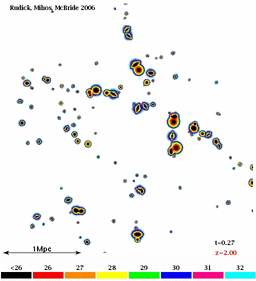|
|
Mihos awarded NSF grant to study origins of intracluster light
|
Posted 12-Jul-2007
The National Science Foundation has awarded CWRU astronomer Chris Mihos
a three year grant to study the origins of the faint intracluster light (ICL)
found in galaxy clusters.
This intracluster light forms as galaxies collide and interact
gravitationally within the cluster. The gravitational forces strip stars out of their parent galaxy,
leaving them strewn throughout the cluster to form a diffuse web of faint ICL.
Mihos, CWRU graduate student Craig Rudick, and Pittsburgh graduate student Cameron McBride
(2003 CWRU Physics BS) are using computer simulations of galaxy clusters to study the detailed
evolution of this ICL. Of particular interest are estimates of the spatial structure, color,
and kinematics of the ICL, all of which contain information about how clusters
grow over cosmic time.
|

|
The animation above shows the evolution of a simulated galaxy cluster, where the faint ICL can be seen
being pulled out of galaxies as they interact with each other while the cluster forms. This
visualization, from a 2006 study published in The Astrophysical Journal by Rudick, Mihos, and McBride,
shows the ICL color-coded by its brightness -- at its brightest,
the ICL is more than a hundred times fainter than the blackness of the dark night sky.
Detecting this faint ICL in real galaxy clusters is a hard task indeed. In a separate project also
funded by the NSF, Mihos and Rudick, along with collaborators Paul Harding (CWRU), Heather Morrison
(CWRU), and John Feldmeier (Youngstown State) are using CWRU's Burrell Schmidt telescope to survey the
nearby Virgo Cluster for this faint ICL.
|
|